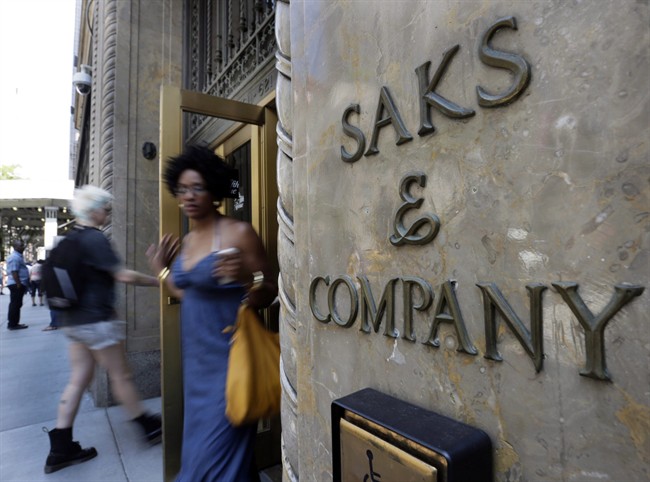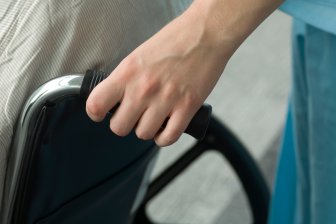TORONTO – With the arrival of Nordstrom north of the border in Calgary and Saks Fifth Avenue waiting in the wings, the U.S. department stores are joining an increasingly crowded field of players banking on Canadian fans of high-end goods to spread the love — and wealth — to their shops.

Homegrown brands are bracing for the influx of fresh competition by shoring up or bolstering their operations.
READ MORE: Hudson’s Bay proving the department store is alive and well
Luxury menswear retailer Harry Rosen has enlarged four of its existing locations and has three major stores opening in 2015, said chairman and CEO Larry Rosen.
“It became obvious to us two, three, four years ago there was going to be an American invasion in our segment of retail, that a number of department stores were going to come here, and we obviously sat back to develop a strategy,” Rosen said in an interview.
“When we sat back and we thought about it, we realized that we could turn an increasingly competitive situation into a positive — into a competitive strength.”
With Holt Renfrew poised to open new locations and expand existing major stores in the coming years and Quebec-based retailer Simons readying to launch in cities across the country beginning in 2015, Canadian consumers will be rich for choice with the imminent boom in luxury offerings. Yet with so many locations selling upscale, big-ticket items, will homegrown shoppers be able to shell out enough to support all of the competing players?
Ernst & Young partner Daniel Baer said what distinguishes many of the high-end retailers entering the marketplace is that they’re concentrated in major urban centres like Vancouver, Calgary, Toronto and Montreal and are opening limited stores in those cities.
“They’re relatively targeted where there are people that have disposable income and where there is, as well, the ability to attract tourist dollars,” said Baer, who also serves as national retail and consumer products industry leader for Ernst & Young.
READ MORE: Is Canada wealthy enough for Saks and wave of fellow luxury stores?
“I think there will be the right balance in those marketplaces. Where it will become a little more interesting in my mind is when you’re competing with a lot more stores in that aspirational upper middle class, because in that tranche, they are looking at a lot more stores, in fact,” he added. “That’s where I think the competition will be especially fierce: the Nordstrom Rack, hr2 of Holt Renfrew fame, the (Saks Fifth Avenue Off 5th) — that category.”
Brynn Winegard, a marketing expert with Winegard & Company, says Canadians tend to be more value-conscious and less price sensitive compared to Americans.
“We are a lot more accepting of higher prices if we believe the value is there. And our economy is one that is padded enough that our consumers, our people, stay fairly affluent through the business cycle,” she said.
“Our retailers and our consumer spending doesn’t shift or sway as much through the business cycle – as an example – we see in the U.S. What that means for Canadian retail in general … is that Canadians — even in downturns — have good affluence in order to be able to spend.”
Winegard said there is also a category of consumers who practise what she describes as “prestige shopping” where they’ll skimp on “low involvement” categories of goods and spend more on those in the “identity” or “high involvement” categories.
“My example is always the following: people who will go to Wal-Mart for socks and Holt Renfrew for denim — and there’s a lot of them.”
Saks Fifth Avenue is slated to open its first two Canadian locations in Toronto in 2016.
Nordstrom recently launched north of the border at the Chinook Centre in Calgary, and is set to open additional stores at the Pacific Centre in Vancouver and Rideau Centre in Ottawa next year. Toronto will be home to three Nordstrom locations: Yorkdale Shopping Centre and Toronto Eaton Centre in 2016 and at Sherway Gardens in the city’s west end in 2017.
A crowded luxury field?
While luxury retailers may be counting on outside visitors to spend, Trendex North America president Randy Harris questioned whether such hopes will translate to real sales.
“People keep talking about the tourist business, but the question is, is a tourist coming into downtown Toronto going to get on a bus and go to Sherway Gardens? I don’t think so,” said Harris, whose Toledo, Ohio-based marketing research and consulting firm specializes in the Canadian and Mexican markets.
“When people talk— about ‘We’re going to get increased tourist business,’ I really wonder if we are or not. And remember, there is no city in the world where there are three Nordstroms as close to each other as there (will be) in Toronto.”
Yet the success seen by retailers at Yorkdale — a launch pad for many first-to-Canada stand-alone stores like Versace, Jimmy Choo, Mulberry and Kate Spade New York — may provide hopeful signs to competitors in the luxury category. Yorkdale general manager Claire Santamaria said retailers housed within the mall often perform better than they expected.
“We’ve seen that for years,” she said. “We really started that branch into luxury with Holt Renfrew … and then with Tiffany, and then we had Burberry. And each time we had one of these brands open in the shopping centre, we often found that they underestimated that consumer demand.”
Baer said luxury retailers don’t compete for customers solely on product but also service — a tool he described as a “critical differentiator.” The challenge for companies will be to ensure that they provide the experience to which people are accustomed, and deliver on what people’s perception of the brand is, he added.
“It’s hard to recover if you don’t meet that offering right off the bat.”



Comments